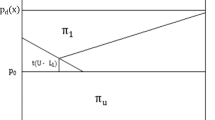Abstract
This paper uniquely demonstrates the scope for profitable collusion on transport costs under delivered pricing. In addition to being profitable, such collusion is shown to be more stable than price collusion and harder to detect as it presents to authorities as continued Bertrand price competition. Such collusion generates endogenous duopoly locations outside the quartiles with less stable but more profitable collusion happening toward the endpoints. These results emerge in both the traditional model of inelastic demand and an extended model of elastic demand.






Similar content being viewed by others
Notes
As a potential illustration, firms engaged in delivered pricing in China face a well-known and routine increase in shipping costs around specific holidays when demand is greater. These increases involve multiple competing firms (see China Daily 2017).
The school milk markets case in Ohio is discussed in detail by Porter and Zona (1999).
They identify price fixing as the first type and concerted action against rivals as the second type.
These two cases and many others are described in more detail by Lande and Marvel (2000).
In other contexts, increased transport cost also increases profit under spatial price discrimination. Gupta et al. (1995) show that the downstream firm can profitably increase transport costs as the upstream firm fears losing market demand and so accommodates by lowering the input price. Similarly, Heywood and Pal (1996) show that a spatial monopoly playing a game against a tax authority can likewise increase its transport cost and so reduce taxes while increasing profitability.
Introducing a fixed cost associated with the one-time location decision does not change our results. Similarly, modeling a case with locations that change without cost for the cheating and punishment phase (see Andree et al. 2018) generates very similar results - available upon request. Left not modeled is the possibility of such relocation in the face of relocation costs.
Alternative assumptions would change the competitive locations known to be at the quantiles with a uniform distribution (Hurter and Lederer 1985). Thus, a normal distribution around the middle would tend to bring competitive location choices toward the middle and bi-modal distributions could drive competitive locations toward the corners.
This conclusion that independent adoption of endogenous costs minimizes costs carries over to the elastic demand case of Gupta and Venkatu (2002).
While the most common, see Miklós-Thal (2008) for alternative punishment strategies. Also recognize that we ignore other factors that might influence cartel stability such as detection lags in identifying the cheater and expected antitrust costs of cartel prosecution.
We recognize that the greater stability of colluding on costs may be irrelevant if the actual discount rates are never above those required for price collusion. In this case price collusion would simply be anticipated.
References
Andree K, Heywood JS, Schwan M, Wang Z (2018) A spatial model of cartel stability: the influence of production cost convexity. Bull Econ Res 70:298–311
Carlton DW (1983) A reexamination of delivered pricing systems. J Law Econ 26(1):51–70
Chang MH (1992) Intertemporal product choice and its effects on collusive firm behavior. Int Econ Rev 33:773–793
China Daily (2017) Chinese courier companies raise prices ahead of ‘shopping festival’. http://www.chinadaily.com.cn/a/201710/11/WS5a0bfb3ba31061a738405b6.html. 11 Oct 2017
Colombo S (2012) Collusion in two models of spatial competition with quantity: setting firms. Ann Reg Sci 48:45–69
Colombo S (2013) Product differentiation and collusion sustainability when collusion is costly. Mark Sci 32:669–674
Dekel E, Scotchmer S (1990) Collusion through insurance: sharing the cost of oil spills. Am Econ Rev 80:249–252
Greenhut ML (1981) Spatial pricing in the United States, West Germany and Japan. Economica 48:79–86
Greenhut J, Greenhut ML, Li S (1980) Spatial pricing patterns in the United States. Quart J Econ 94:329–350
Gupta B (1994) Competitive spatial price discrimination with strictly convex production costs. Reg Sci Urban Econ 24:265–272
Gupta B, Venkatu G (2002) Tacit collusion in a spatial model with delivered pricing. J Econ 76:49–64
Gupta B, Heywood JS, Pal D (1995) Strategic behavior downstream and the incentive to integrate: a spatial model with delivered pricing. Int J Ind Organ 13:327–334
Hackner J (1995) Endogenous product design in an infinitely repeated game. Int J Ind Organ 13:277–299
Hamilton JH, Thisse JF, Weskamp A (1989) Spatial discrimination: bertrand vs. cournot in a model of location choice. Reg Sci Urban Econ 19(1):87–102
Hendel I, Neiva-de-Figueiredo J (1997) Product differentiation and endogenous disutility. Int J Ind Organ 16:63–79
Heywood JS, Pal D (1996) How to tax a spatial monopolist. J Public Econ 61:107–119
Heywood JS, Wang Z (2015) How to license a transport innovation. Ann Reg Sci 55:485–500
Heywood JS, Li D, Ye G (2020) Does price discrimination make collusion less likely? A delivered pricing model. J Econ Forthcom. https://doi.org/10.1007/s00712-020-00699-4
Hurter AP, Lederer PJ (1985) Spatial duopoly with discriminatory pricing. Reg Sci Urban Econ 15:541–553
Hurter AP, Lederer PJ (1986) Competition of firms: discriminatory pricing and location. Econometrica 46:623–640
Johnson JC (1976) How competitive is delivered pricing? J Purch Mater Manag 12:26–30
Lande RH, Marvel HP (2000) The three types of collusion: fixing prices, rivals and rules. Wisconsin Law Rev 2000:941–999
Matsumura T, Matsushima N (2005) Cartel stability in a delivered pricing oligopoly. J Econ 86:259–292
McChesney FS, Shughart WF (2007) Delivered pricing in theory and policy practice. Antitrust Bull 52:205–228
Miklós-Thal J (2008) Delivered pricing and the impact of spatial differentiation on cartel stability. Int J Ind Organ 26:1365–1380
Phillips EE (2018) Companies spent a record $1.5 trillion on shipping costs in 2017. The Wall Str J. Viewed on-line March 22, 2019, https://www.wsj.com/articles/companies-are-spending-more-on-shipping-and-thats-not-changing-soon-1529413500. 19 June 2018
Piccolo S, Mikos-Thal J (2012) Colluding through suppliers. Rand J Econ 43:492–513
Porter RH, Zona JD (1999) Ohio school milk markets: an analysis of bidding. Rand J Econ 30:263–288
Staiger RW, Wolak FA (1992) Collusive pricing with capacity constraints in the presence of demand uncertainty. Rand J Econ 23:203–220
Thisse JF, Vives X (1988) On the strategic choice of spatial price policy. Am Econ Rev 78:122–137
Von Ungern-Sternberg T (1988) Monopolistic competition and general purpose products. Rev Econ Stud 55:231–246
Acknowledgements
Zheng Wang acknowledges financial support from the National Natural Science Foundation of China [grant numbers 71803137 and 71733001].
Author information
Authors and Affiliations
Corresponding author
Additional information
Publisher's Note
Springer Nature remains neutral with regard to jurisdictional claims in published maps and institutional affiliations.
Appendices
Appendix 1: the expression of \(\delta^{*}\) for inelastic demand
Appendix 2: deriving unit transport cost under competition with elastic demand
Due to the symmetry, we impose \(L_{2} = 1 - L_{1}\) and \(t_{2} = t_{1}\) to \(\partial \pi_{1}^{C} /\partial t_{1}\), where \(\pi_{1}^{C}\) is shown in (15). This yields: \(\frac{{\partial \pi_{1}^{C} }}{{\partial t_{1} }} = \left( { - \frac{4}{3}L_{1}^{3} + \frac{3}{2}L_{1}^{2} - \frac{1}{2}L_{1} + \frac{1}{12}} \right)t_{1} - L_{1}^{2} + \frac{{L_{1} }}{2} - \frac{1}{8} { \gtrless }0\) if \(t_{1} { \gtrless } - \frac{{3\left( {8L_{1}^{2} - 4L_{1} + 1} \right)}}{{2\left( {16L_{1}^{3} - 18L_{1}^{2} + 6L_{1} - 1} \right)}}\). It can be shown that \(- \frac{{3\left( {8L_{1}^{2} - 4L_{1} + 1} \right)}}{{2\left( {16L_{1}^{3} - 18L_{1}^{2} + 6L_{1} - 1} \right)}} > 0.9\) for \(L_{1} < 1/2\). Thus, the optimal unit transport costs for both firms are: \(t_{1}^{C} = t_{2}^{C} = \underset{\raise0.3em\hbox{$\smash{\scriptscriptstyle-}$}}{t}\).
Rights and permissions
About this article
Cite this article
Heywood, J.S., Wang, Z. Profitable collusion on costs: a spatial model. J Econ 131, 267–286 (2020). https://doi.org/10.1007/s00712-020-00709-5
Received:
Accepted:
Published:
Issue Date:
DOI: https://doi.org/10.1007/s00712-020-00709-5




